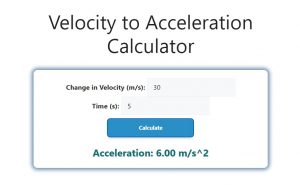About Velocity to Acceleration Calculator (Formula)
The Velocity to Acceleration Calculator is a useful tool for students, engineers, and anyone involved in physics or motion studies. Acceleration measures how quickly an object’s velocity changes over time. Understanding the relationship between velocity and acceleration is essential in various fields, including automotive engineering, physics, and aerospace. This calculator helps users determine acceleration easily, allowing for better analysis and application of motion principles.
Formula
The formula to calculate acceleration is:
A = dV / dt
Where:
- A represents acceleration (in meters per second squared, m/s²).
- dV is the change in velocity (in meters per second, m/s).
- dt is the change in time (in seconds, s).
How to Use
- Determine the initial velocity: Identify the starting velocity of the object.
- Determine the final velocity: Measure the final velocity after a given time period.
- Calculate the change in velocity (dV): Subtract the initial velocity from the final velocity (dV = final velocity – initial velocity).
- Determine the time interval (dt): Measure the time over which the velocity change occurs.
- Apply the formula: Divide the change in velocity by the time interval to find acceleration.
- Check units: Ensure that all measurements are in consistent units for accurate results.
Example
Let’s say a car accelerates from an initial velocity of 20 m/s to a final velocity of 50 m/s over a time interval of 5 seconds. First, calculate the change in velocity:
dV = final velocity – initial velocity
dV = 50 m/s – 20 m/s
dV = 30 m/s
Now, apply the formula:
A = dV / dt
A = 30 m/s / 5 s
A = 6 m/s²
In this case, the car’s acceleration is 6 meters per second squared.

FAQs
- What is a velocity to acceleration calculator?
A tool that helps convert changes in velocity over time into acceleration values. - Why is acceleration important in physics?
Acceleration indicates how quickly an object is speeding up or slowing down, which is crucial for understanding motion dynamics. - What units are used for acceleration?
Acceleration is typically measured in meters per second squared (m/s²). - How is change in velocity calculated?
Change in velocity (dV) is calculated by subtracting the initial velocity from the final velocity. - What is the significance of the time interval (dt)?
The time interval is essential for determining how long the change in velocity occurs, affecting the acceleration calculation. - Can this calculator be used for negative acceleration?
Yes, negative acceleration (deceleration) can be calculated the same way, resulting in a negative value. - How do I determine initial and final velocity?
Initial velocity is the speed at which an object starts, while final velocity is its speed after a certain time or change in motion. - What is the difference between speed and velocity?
Speed is a scalar quantity (magnitude only), while velocity is a vector quantity (magnitude and direction). - Is acceleration constant in all scenarios?
No, acceleration can vary depending on the forces acting on an object, such as friction or gravity. - How does this calculator apply to real-world situations?
It can be used in various applications, such as analyzing vehicle performance, understanding sports motion, or studying projectile motion. - What happens if dt is zero?
If dt is zero, the formula cannot be applied as division by zero is undefined. - Can I use this calculator for circular motion?
Yes, but for circular motion, you may need to consider angular acceleration in addition to linear acceleration. - What is the formula for average acceleration?
Average acceleration can be calculated using the same formula: A = dV / dt. - Can this calculator help in designing vehicles?
Yes, understanding acceleration is crucial for vehicle design and performance assessment. - How does acceleration relate to force?
According to Newton’s second law, acceleration is directly proportional to the net force acting on an object and inversely proportional to its mass. - What is the maximum acceleration a car can achieve?
The maximum acceleration depends on factors like tire grip, engine power, and weight distribution. - How can I increase acceleration in a vehicle?
Acceleration can be increased by reducing weight, increasing engine power, or enhancing traction. - Are there any tools to measure acceleration directly?
Yes, accelerometers are devices used to measure acceleration in various applications. - Can this calculator be used for sports analysis?
Absolutely! Athletes’ performance can be analyzed using acceleration to optimize training and improve results. - Where can I find more resources on acceleration and velocity?
You can explore physics textbooks, online courses, and educational websites focused on motion and mechanics.
Conclusion
The Velocity to Acceleration Calculator is an invaluable tool for anyone studying motion. By understanding how to calculate acceleration from changes in velocity over time, users can gain insights into the dynamics of objects in motion. This knowledge is crucial in various fields, including engineering, sports science, and physics, enabling better design, analysis, and optimization of performance across many applications.